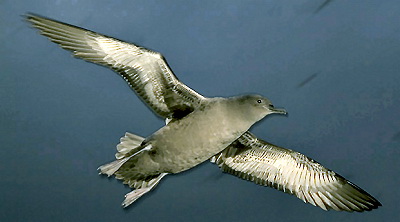Sooty Shearwater
From Wikipedia, the free encyclopedia
Order: Procellariiformes
Family: Procellariidae
[Photo] Sooty Shearwater (Puffinus griseus). Author: Thomas Mattern. Institution: Department of Zoology, University of Otago, Dunedin, New Zealand. Image date: 02.11.2003. Image location: The Snares, New Zealand. Notes: Image taken in the evening (with flash), over the North East Island's forest canopy. License: GNU-FDL Copyright (C) 2003 Thomas Mattern
Permission is granted to copy, distribute and/or modify this document under the terms of the GNU Free Documentation License, Version 1.2 or any later version published by the Free Software Foundation; with no Invariant Sections, no Front-Cover Texts, and no Back-Cover Texts. A copy of the license is included in the section entitled "GNU Free Documentation License". |
The Sooty Shearwater (Puffinus griseus) is a medium-large shearwater in the seabird family Procellariidae. In New Zealand it is also known by its M??ori name t??t?? and as muttonbird, like the Wedge-tailed Shearwater and the Australian Short-tailed Shearwater.
Systematics
It appears to be related to the Great and Short-tailed Shearwater, all blunt-tailed, black-billed species, but its precise relationships are obscure. These are among the larger species of shearwater which might belong into a separate genus, Ardenna.
Description
This bird is 40-50 cm in length with a 95-110 cm wingspan. It has the typically "shearing" flight of the genus, dipping from side to side on stiff wings with few wing beats, the wingtips almost touching the water. Its flight is powerful and direct, with wings held stiff and straight, giving the impression of a very small albatross. This shearwater is identifiable by its dark Feather plumage which is responsible for its name. In poor viewing conditions it looks all black, but in good light it shows as dark chocolate-brown a silvery strip along the center of the underwing. In the pacific part of its range, other all-dark large shearwaters are found, but in the atlantic, it is the only such bird.
Distribution and movements
Sooty Shearwaters breed on small islands in the south Pacific and south Atlantic Oceans, mainly around New Zealand, the Falkland Islands and Tierra del Fuego.
They are spectacular long-distance migrants, following a circular route, travelling north up the western side of the Pacific and Atlantic Oceans at the end of the nesting season in March-May, reaching sub arctic waters in June-July where they cross from west to east, then returning soth down the eastern side of the oceans in September-October, reaching to the breeding colonies in November. They do not migrate as a flock, but rather as single individuals, associating only opportunistically; in 1906 for example, two were shot near Guadalupe Island off Baja California (Mexico), several weeks before the bulk of the population would pass by.
In the Atlantic Ocean, they cover distances in excess of 14,000 km (9,000 miles) from their breeding colony on the Falkland Islands (52°S 60°W) north to 60° to 70°N in the North Atlantic Ocean off north Norway; distances covered in the Pacific are similar or larger; although the Pacific Ocean colonies are not quite so far south, at 35° to 50°S off New Zealand, and moving north to the Aleutian Islands, the longitudinal width of the ocean makes longer migrations possible. Recent tagging experiments have shown that birds breeding in New Zealand may travel 74,000 km in a year, reaching Japan, Alaska and California, averaging more than 500 km per day.
In Great Britain, they move south in late August and September; with strong N/NW winds, they may become 'trapped' in the shallow, largely enclosed North Sea, and heavy passages may be seen flying back north up the British east coast as they re-trace their steps back to the Atlantic over northern Scotland.
Behavior
The Sooty Shearwater feeds on fish and squid. They can dive up to 68 m deep for food, but more commonly take surface food, in particular often following whales to catch fish disturbed by them. They will also follow fishing boats to take fish scraps thrown overboard.
It breeds in huge colonies and lays one white egg. These shearwaters nest in burrows lined with plant material which are visited only at night to avoid predation by large gulls.
Vocalizations
Usually loud, Sooty Shearwaters coo and croak while on the breeding grounds.
Use by humans
In New Zealand, t??t?? are traditionally harvested each year by the native M??ori. Young birds just about to fledge are collected from the burrows, plucked and often preserved in salt. As a consequence, the consumption of cooked t??t?? can be somewhat of a salty experience.
http://en.wikipedia.org/wiki/Sooty_Shearwater
| The text in this page is based on the copyrighted Wikipedia article shown in above URL. It is used under the GNU Free Documentation License. You may redistribute it, verbatim or modified, providing that you comply with the terms of the GFDL. |
|

